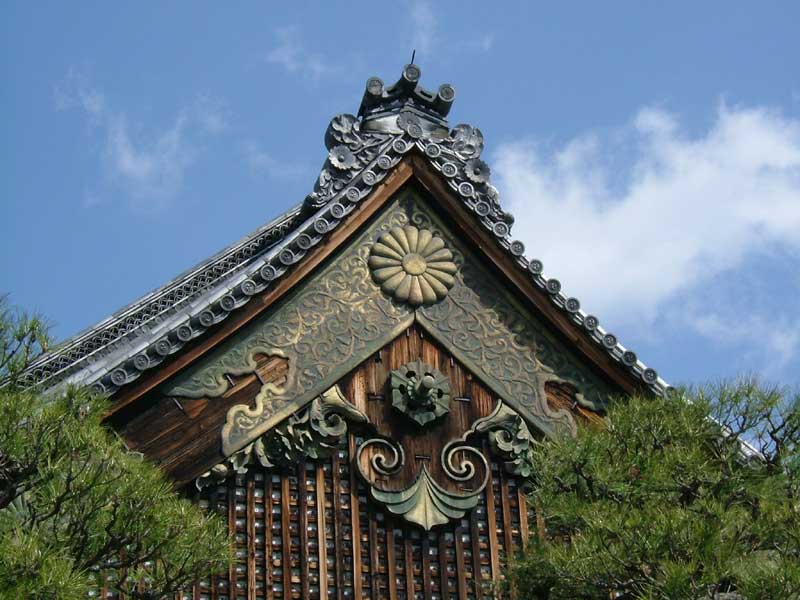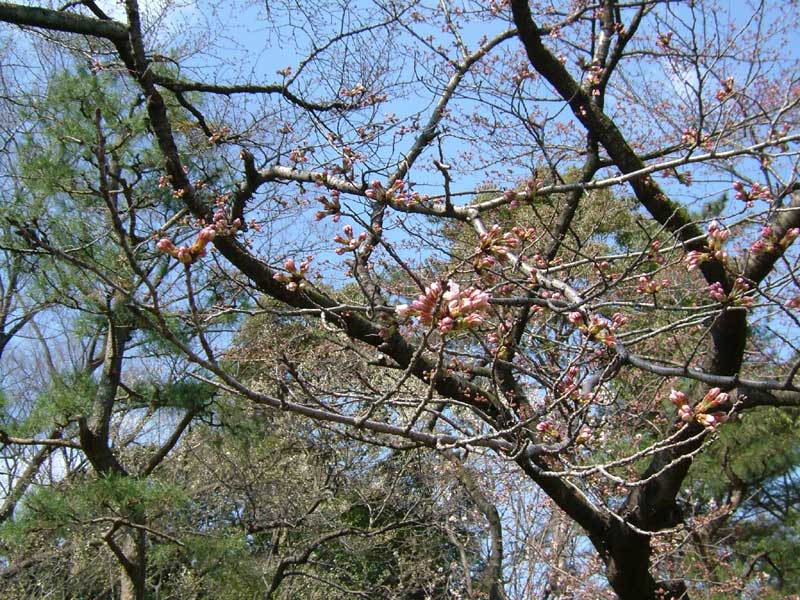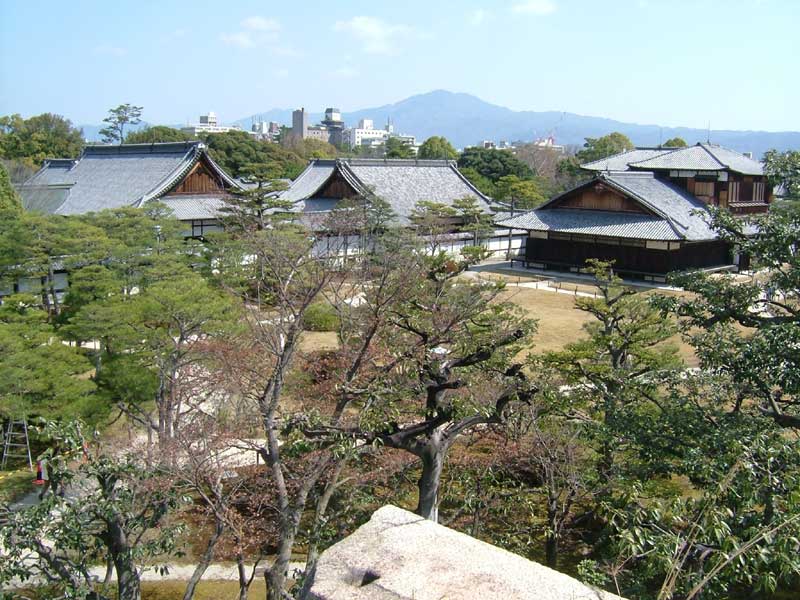

Nijo-jo, or "Two Article Castle" if you trust the dictionary (which is a good example of why you should never trust a Japanese-English dictionary), is the ancient Kyouto residence of the Shogun. It was built in 1603 by the Shogun Ieyasu and was eventually given to the Emperor in 1867. The Shogun controlled the daimyou, or feudal lords, who in turn controlled the samurai or bushi--the feudal warriors. In effect, the Emperor was a guy who sat in his palace and held fancy courts, while the Shogun took care of all of the administrative chores of running the nation.
Click on an area to see it, or just scroll down.
We approached Nijo-jo from the corner, and so Kim took Peter's picture in front
of one of the corner towers of the castle. Unlike the temple walls, which for
some reason are also fortified, this wall is made from stone. Most of the temples
and even the Imperial Palace have earthen walls molded with wood.
Back to map...
There's also a substatial moat. In fact, their are two moats. This is the primary
moat. This wall is actually pretty low and the moat isn't terribly wide.
Back to map...
Here is the main gate to the castle. It's huge and clad in iron. The doors
are enormous and have gigantic bolts... it must take half an army just to close
and open the gates. Above the gate you can see some slits--this was where the
defenders could attack gate-crashers from above. You can also get a glimpse
of a secondary wall made out of earth and wood.
Back to map...
Behind this secondary wall, and through this very ornate gateway, is the castle
complex. Kim is hunched over in her "guided pointing" position. Ganbatte
Kim!
Back to map...
This is the Shogun's castle. The real name is Ninomaru Palace. It's now a huge
museum; however, photography was strictly forbidden. It's a shame, because the
inside was really interesting. One area we saw was the Shogun's reception room.
It was built on two levels, with one slightly higher than the other. The Shogun
would sit on the higher level to receive his visitors, who were his lessers,
except when an Imperial messenger came. In this case the messenger would sit
on the higher level and the Shogun on the lower level because the Shogun was
technically subordinate to the Emperor.
Back to map...

This is a good photo of the detail at the crest of the castle roof. It's really,
really impressive. The flower at the center is a chrysanthemum--the symbol of
the Emperor and his family.
Back to map...
And of course no castle would be complete without a garden. This is the Ninomaru
garden. The shapes of the ponds, rocks, and everything else, was carefully designed
by a famous tea master and architect in the 1600s. Hairanaide kudasai! (Please
keep off!)
Back to map...
But this castle wasn't built simply for beauty. In times of trouble, the Shogun
had another, much sturdier, line of defense. This is the rather spartan entrance
to the inner castle area.
Back to map...
This is a good side view of the quite more substantial moat and more daunting
solid stone wall protecting this part of the castle complex. The bridge is made
out of a nice cheap wood, very easy for burning for extra defense.
Back to map...
The walls are a good ten feet thick and fifteen tall. The Tokugawa Shogun ruled
over a period when Japan was beginning to import and manufacture gunpowder,
cannonry, and firearms, so this wall is designed to resist that kind of firepower.
Back to map...
Unfortunately, the actual castle in the inner compound didn't make it through
to the modern day. It was consumed by fire and never rebuilt. In its place,
the Meiji Emperor sent one of the extra Tokyo castles in the 19th century. It
was moved here. The inner castle area is called honmaru. This Tokyo castle is
opened in the fall for public viewing.
Back to map...
The inner compound does have a really nice selection of gardens, though. It
is called Seiryu-en. The trees behind Kim are starting to bloom. Plum blossoms
are in season.
Back to map...

Sakura, or cherry blossoms, however, haven't yet entered into full effect.
This was the state of sakura in Kyouto when we arrived in late March. Sakura
blooms first in southern Kyushu, then makes its way northwards through March
and April, finally blooming in Hokkaido in May.
Back to map...
There was a place to climb one of the corners of the large wall surrounding
the inner castle. Here Kim is peering out into the city.
Back to map...

This shows a good bit of the castle complex itself. There's also an interesting
contrast between the castle buildings and the modern high-rises in the background.
Back to map...